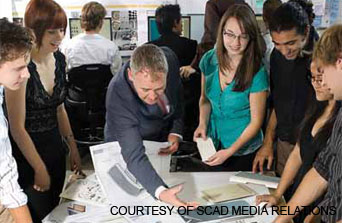One small acronym is causing big buzz at SCAD.
The letters Q,E and P have been popping up all over in recent weeks — from an informational video on SCAD’s Web site to the background of every computer in the university’s labs. Many students have noticed, but few are clear on what the letters mean.
“I saw it on the computers, but I don’t know what it is,” second-year sculpture graduate student Stephen Hayes said of the QEP, which stands for Quality Enhancement Plan.
Although students are just getting wind of this of the QEP business, it’s not a new effort. SCAD has been working to develop a QEP since the end of 2007.
Its purpose is to improve student learning at the college and is one part of SCAD’s coming reaffirmation visit from Southern Association of Colleges and Schools, Commission on Colleges, the regional body for the accreditation of degree-granting institution in the Southern states. SACS requires that all schools have a QEP in place to stay in line with its Principles of Accreditation.
According to Chris Brandner, SCAD’s director of admission, there are two parts to the accreditation process. One part is compliance, which “looks retrospectively at the college, [to see] that it is doing what it said it was going to do,” she said, and the second part is the QEP.
“The QEP is the really exciting part,” Brandner said, “because that is projecting into the future and coming up with a plan of what the college wants to do.
“It’s not only what the college wants to do,” she added. “It’s one main topic or scope that the college wants to put a lot of energy in for the next 10 years.”
Brandner was on the original QEP advisory committee “that did a lot of research and facilitated the process before we got to this point.”
During the research stage, a blog was created to solicit ideas for the QEP. According to the blog, the committee received 63 submissions during the solicitation period and of those submissions, four drafts were submitted to the president’s cabinet for consideration.
Out of the four drafts came SCAD’s QEP, A Triptych for Collaboration, which falls in line with SCAD’s career-driven focus. Named after a three-paneled picture, the idea behind the Triptych for Collaboration is to have students, professors and outside partners come together, allowing students to create real-world projects for course credit.
“Students get the chance to solve real problems and develop real solutions in real courses that give them credits. Their work will be measured against some very demanding criteria,” Peter Fossick, a professor of industrial design, wrote in an e-mail.
A member of the later QEP committee, Fossick is also the talking head in the online videos, explaining SCAD’s QEP.
“Students practice and hone their professional and interpersonal skills, develop amazing portfolio assets and have an experience they can include on their resume that differentiates them from other graduates that they might compete with for that first or second job,” he wrote. “Collaborative learning projects lead to life-changing experiences.”
According to Fossick, the hub of SCAD’s QEP will be the Collaborative Learning Center, for which he serves as director. Although no site or projected opening date have been selected, there are plans for a physical location for the center. That will come after SCAD goes through the approval process for QEP, he said.
“Once SCAD has been through this process we have the ability to move forward with the plan quickly,” Fossick wrote in the e-mail.
Although the official plan is new, the idea of collaboration at SCAD is not.
“There’s always been a little bit of a culture of collaboration [at SCAD],” Brandner said. “But now that collaboration has been chosen for the QEP, the college can really expand the opportunities to all of the students and can really support it with resources.
“And once it’s approved, then we get to move forward with it wholeheartedly,” she said.
According to Fossick, the review process begins at the end of February and will be completed by March 3.
“SCAD will then receive recommendations and feedback that will be used to hone our QEP, leading to approval and then SCAD can implement,” Fossick said. “We are all looking forward to the review process and gaining the perspective of the review panel.”
The QEP will encompass SCAD’s Savannah, Atlanta, Lacoste and Hong Kong locations, as well as eLearning.
“In the coming months, students will receive more information on this important initiative,” SCAD Vice President P.J. Johnson said in an e-mail.
For now, though, more details about the QEP can be found at scad.edu/qep.





















